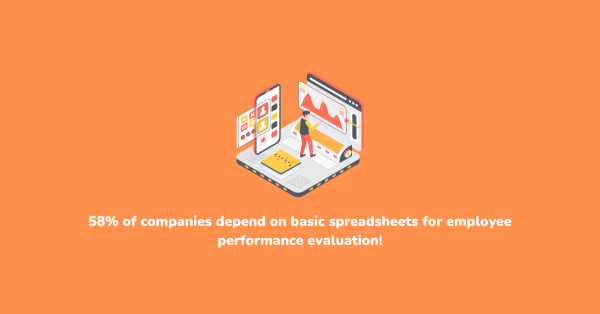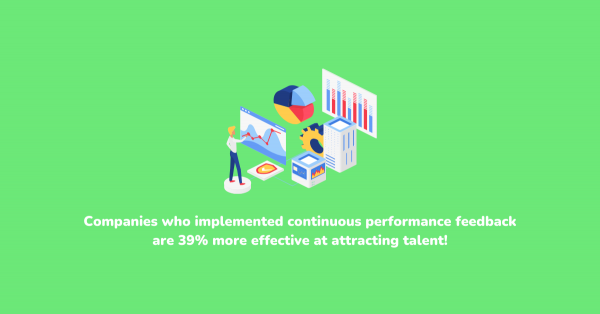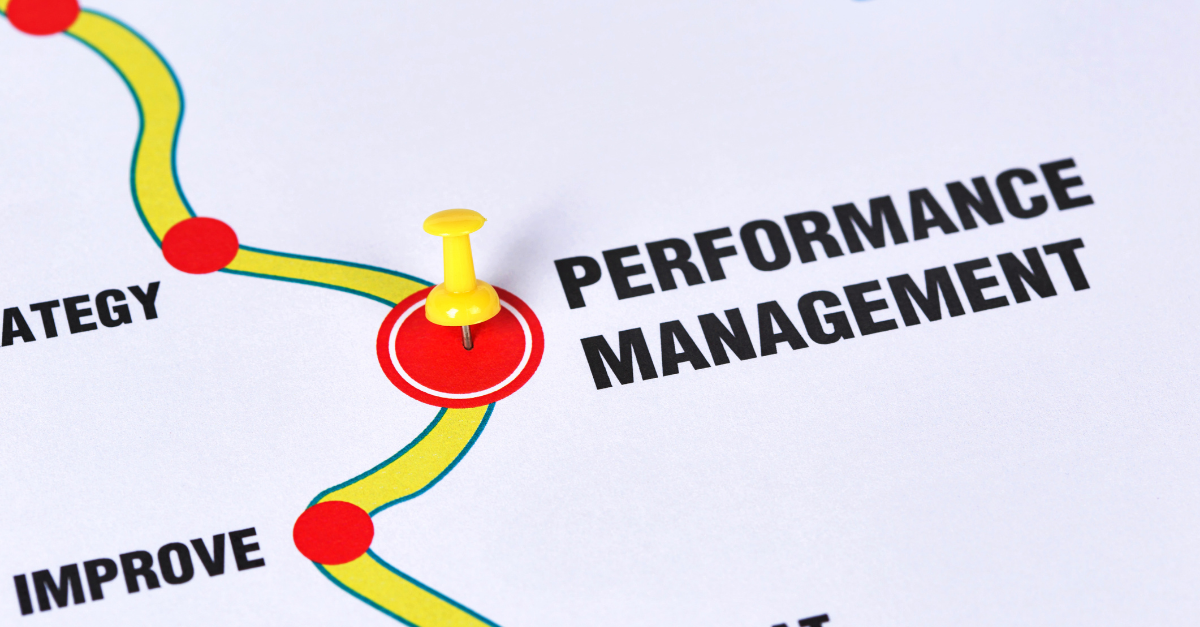Performance management is a strategic approach organizations employ to enhance employee performance, align individual goals with organizational objectives, and foster a high-performance culture. At its core, it's a systematic process of setting clear expectations, providing regular feedback, measuring performance, and developing employees to achieve their full potential.
Traditionally, performance management has been a predominantly manual process, reliant on paper-based forms, spreadsheets, and in-person meetings. While this method has served its purpose, it is increasingly becoming apparent that it falls short in today's fast-paced and competitive business environment. Complex performance management processes often suffer from inefficiencies, inaccuracies, and a lack of real-time insights.
To address these challenges, organizations are turning to performance management software as a transformative solution. This software empowers businesses to streamline the performance management process to implement continuous performance management, gather actionable data, and drive employee engagement. By automating many of the time-consuming tasks associated with performance reviews, goal setting, and feedback, performance tools frees up HR professionals and managers to focus on more strategic initiatives.
Moreover, it provides a centralized platform for storing and accessing employee performance data, enabling organizations to make data-driven decisions regarding talent development, succession planning, and compensation. With the ability to track employee progress over time, performance tools offer valuable insights into individual and team performance, facilitating targeted interventions and coaching.
In essence, performance tools are a catalyst for organizational success. By aligning employee performance with business objectives, it contributes to increased productivity, improved employee engagement, and ultimately, a stronger bottom line.
Understanding the Challenges of Manual Performance Management
Manual performance management systems are fraught with challenges that hinder organizational efficiency, employee development, and overall performance. Beyond the previously discussed issues of time consumption, data accuracy, and goal alignment, several specific problems arise.
Human Error and Subjectivity
- Rater Bias - Rater bias, a pervasive issue in manual performance management, often leads to skewed evaluations. Managers may unconsciously favor or disfavor employees based on personal opinions, stereotypes, or recent events. This subjectivity undermines the fairness and accuracy of performance assessments.
- Inconsistent Ratings - Inconsistent ratings across the organization further compound the problem. Different managers may apply varying standards and criteria, making it difficult to compare employee performance objectively. This lack of standardization hinders talent identification and development.
- Calculation Errors - Moreover, manual calculations of performance metrics are prone to human error, leading to inaccuracies in data analysis. Errors in data entry or calculations can distort performance trends and impact decision-making.
Lack of Visibility and Transparency
- Limited Access to Data - Manual systems often suffer from limited access to performance data, hindering strategic decision-making. Without a centralized repository of information, it is challenging to analyze performance trends, identify top performers, and assess the effectiveness of development initiatives.
- Delayed Feedback - Delayed feedback is another critical issue. Traditional annual reviews provide limited visibility into employee performance throughout the year, making it difficult to address performance issues promptly or recognize achievements in a timely manner. This lack of real-time feedback can hinder employee development and motivation.
- Lack of Goal Alignment - Manual systems often struggle to demonstrate the alignment between individual and organizational goals. Employees may not clearly understand how their work contributes to the company's overall success, leading to decreased engagement and productivity.
Inefficiency and Administrative Burden
- Time-Consuming Processes - Manual performance management processes are notoriously time-consuming, consuming valuable resources that could be allocated to more strategic activities. From collecting and organizing performance data to conducting reviews and generating reports, the administrative burden is significant.
- Resource Allocation Challenges - This inefficiency can lead to resource allocation challenges as managers and HR professionals devote excessive time to administrative tasks rather than focusing on employee development and performance improvement.
- Difficulty in Tracking Progress - Additionally, tracking employee progress and goal attainment is difficult with manual systems. Without a centralized platform to monitor performance metrics and milestones, it is challenging to assess employee development and identify training needs.
Limited Feedback and Development Opportunities
- Infrequent Performance Reviews - The traditional annual review cycle is inadequate for providing the ongoing feedback and development support that employees need to succeed. Infrequent performance reviews limit opportunities for coaching, mentoring, and goal setting.
- Lack of Developmental Focus - Moreover, manual systems often prioritize performance ratings over development. The focus on past performance can hinder the ability to identify employees' potential and create development plans to help them reach their full potential.
- Delayed Recognition - Delayed recognition of employee achievements is another consequence of manual systems. Without a timely rewards system, employees may feel undervalued and demotivated.
These challenges underscore the limitations of manual performance management systems and highlight the need for a more efficient, accurate, and data-driven approach. By adopting performance management software, organizations can mitigate these issues and create a more effective performance management process.
The Solution

The challenges inherent in manual performance management systems have necessitated a shift. Enter performance management software. This innovative solution offers a comprehensive approach to streamlining the performance management process, enhancing efficiency, and driving organizational success.
Performance management tools serve as a centralized hub for managing employee performance, providing a platform for goal setting, performance reviews, feedback, and development planning. By automating many of the time-consuming tasks associated with traditional performance management, software solutions free up HR professionals and managers to focus on strategic initiatives.
Moreover, performance management tools empower organizations to gather and analyze performance data, providing valuable insights into employee performance trends, strengths, and areas for improvement. These data-driven insights enable informed decision-making regarding talent management, succession planning, and performance improvement strategies.
Ultimately, performance management tools are designed to foster a culture of performance excellence by aligning individual goals with organizational objectives, providing regular feedback, and recognizing and rewarding employee contributions. By streamlining processes, improving data accuracy, and enhancing employee engagement, performance management tools are critical tools for organizations seeking to optimize their talent management strategies.
Understanding Performance Management Software
Performance management tools are robust tools designed to streamline and enhance the entire performance management process. At its core, it provides a centralized platform for managing employee information, setting goals, conducting performance reviews, and tracking progress. By automating many of the time-consuming tasks associated with traditional performance management, software solutions free up HR professionals and managers to focus on strategic initiatives and employee development.
A key feature of performance evaluation software is its ability to facilitate goal setting and alignment. Employees can create specific, measurable, achievable, relevant, and time-bound (SMART) goals that contribute to overall organizational objectives. The software often includes tools for cascading goals down the organizational hierarchy, ensuring that everyone is working towards a common purpose.
Performance reviews are a cornerstone of effective performance management, and performance evaluation software offers a structured approach to this process. It provides templates for review forms, simplifies the rating process, and enables managers to provide meaningful feedback. Additionally, software solutions often incorporate features for self-assessment, allowing employees to reflect on their performance and identify areas for improvement.
Another critical component of performance evaluation software is talent management. The software can be used to identify high-potential employees, create development plans, and track employee career progression. It also provides tools for succession planning, ensuring that the organization has the talent pipeline in place to meet future business needs.
By leveraging performance evaluation software, organizations can gain valuable insights into employee performance. The software can generate reports and analytics that highlight trends, identify top performers, and pinpoint areas for improvement. These insights can inform talent management decisions, resource allocation, and performance improvement initiatives.
In conclusion, performance evaluation software is a powerful tool that can transform the way organizations manage their workforce. By automating processes, improving data accuracy, and providing valuable insights, it empowers organizations to achieve their strategic goals and create a high-performance culture.
Benefits of Using Performance Management Software
Performance evaluation software offers a multitude of benefits that can significantly enhance organizational performance and employee engagement. By automating processes, providing valuable insights, and fostering a culture of continuous improvement, this technology can drive positive outcomes for businesses of all sizes.
Improved Efficiency and Productivity
- Time Savings - Employee appraisal software automates routine tasks such as data entry, form generation, and calculations, freeing up HR professionals and managers to focus on strategic initiatives and employee development. By eliminating manual paperwork and reducing administrative burdens, organizations can significantly improve operational efficiency.
- Streamlined Workflows - The software centralizes the performance management process, creating a unified platform for all relevant documentation, communication, and data. This streamlined approach reduces bottlenecks, improves collaboration, and ensures consistency in performance management practices across the organization.
- Increased Productivity - With automated tasks and streamlined workflows, managers and employees can dedicate more time to core responsibilities and value-added activities. This increased focus on strategic initiatives and employee development drives overall productivity and organizational success.
Enhanced Decision Making
- Data-Driven Insights - Employee appraisal software collects and analyzes vast amounts of performance data, providing actionable insights into employee performance trends, strengths, weaknesses, and development needs. These data-driven insights enable organizations to make informed decisions about talent management, succession planning, and resource allocation.
- Talent Identification - By tracking employee performance metrics and identifying high-potential individuals, organizations can effectively identify top performers and invest in their development. This talent identification process helps build a strong talent pipeline and ensures business continuity.
- Succession Planning - Employee appraisal software can be used to create detailed succession plans by identifying potential successors for critical roles. By tracking employee performance, skills, and career aspirations, organizations can proactively develop future leaders and mitigate talent risks.
Improved Employee Engagement
- Increased Employee Satisfaction - Employee appraisal software facilitates regular feedback and recognition, which are essential for boosting employee morale and engagement. By providing timely and constructive feedback, organizations can demonstrate their commitment to employee development and create a positive work environment.
- Goal Alignment - The software aligns individual and organizational goals, creating a clear sense of purpose and direction for employees. By connecting employees' work to the bigger picture, organizations can enhance motivation and engagement.
- Career Development Support -Employee appraisal software offers tools to help employees identify development opportunities, set career goals, and create personalized development plans. By investing in employee growth and advancement, organizations can foster a culture of learning and development, leading to increased job satisfaction and retention.
Enhanced Performance and Development
- Continuous Performance Improvement - Employee appraisal software supports a culture of continuous improvement by enabling regular check-ins, goal setting, and performance feedback. By providing ongoing performance coaching and development opportunities, organizations can help employees reach their full potential.
- Objective Setting and Tracking - The software facilitates the creation of clear, measurable, achievable, relevant, and time-bound (SMART) goals. By tracking progress towards these goals, employees and managers can stay focused on priorities and measure performance effectively.
- Talent Development - Staff appraisal software provides insights into employee strengths, weaknesses, and development needs. This information can be used to create targeted development plans, provide necessary training, and support career advancement.
Compliance and Risk Mitigation
- Documentation - Staff appraisal software maintains a comprehensive record of performance reviews, goal setting, and feedback, ensuring compliance with labor laws and industry regulations.
- Audit Trails - The software generates detailed audit trails that document performance management activities, providing evidence of compliance and facilitating internal and external audits.
- Reduced Risk - By automating performance management processes and ensuring data accuracy, organizations can reduce the risk of errors, biases, and legal challenges associated with manual systems.
By leveraging the power of staff appraisal software, organizations can create a high-performance culture where employees are engaged, motivated, and aligned with organizational objectives. The benefits extend beyond increased efficiency and productivity, encompassing improved decision-making, enhanced employee development, and reduced compliance risks.
Key Features of Performance Management Software
Staff appraisal software offers a range of essential features designed to optimize the performance management process. These features collectively contribute to improved efficiency, data accuracy, employee engagement, and overall organizational performance.
Core Functionalities
- Goal Setting and Management - The software enables organizations to define clear and measurable goals at both individual and organizational levels. It provides tools for cascading goals, tracking progress, and aligning employee objectives with strategic initiatives.
- Performance Reviews - Staff appraisal software facilitates the performance review process by providing templates, rating scales, and automated workflows. It enables managers to conduct regular reviews, provide feedback, and set development plans.
- 360-degree Feedback - Many software solutions offer 360-degree feedback capabilities, allowing employees to receive feedback from peers, subordinates, and managers. This comprehensive feedback approach provides a well-rounded view of employee performance.
- Talent Management - The software supports talent management initiatives by identifying high-potential employees, creating development plans, and tracking career progression. It also provides tools for succession planning and workforce analytics.
Additional Features
- Performance Metrics and Analytics - Performance software collects and analyzes performance data to generate insightful reports and dashboards. These metrics help organizations identify trends, measure performance against goals, and make data-driven decisions.
- Mobile Accessibility - Many software solutions offer mobile apps, enabling employees to access performance information, provide feedback, and set goals on the go.
- Integration Capabilities - The ability to integrate with other HR systems, such as HRIS, payroll, and learning management systems, enhances data consistency and efficiency.
- Compliance Features - Performance software often includes features to help organizations comply with labor laws and industry regulations, such as audit trails and data security measures.
By incorporating these key features, performance software empowers organizations to streamline processes, improve decision-making, and foster a high-performance culture. The choice of features will depend on the specific needs and size of the organization.
Selecting the Right Performance Software

Choosing the right performance software is a critical decision that can significantly impact an organization's success. Several factors should be considered when evaluating software options to ensure a suitable fit for specific needs.
Identifying Your Organization's Needs
- Organizational Size and Structure - The software should align with the company's size, industry, and organizational structure.
- Performance Management Goals - Clearly define the desired outcomes of the performance management process to identify essential software features.
- Budget Constraints - Determine the available budget for software purchase, implementation, and ongoing maintenance.
Key Evaluation Criteria
- Functionality - Assess the software's core features, such as goal setting, performance reviews, feedback mechanisms, and talent management capabilities.
- User-Friendliness - The software should be intuitive and easy to use for both managers and employees.
- Data Security - Ensure the software complies with data privacy regulations and protects sensitive employee information.
- Integration Capabilities - Evaluate the software's ability to integrate with other HR systems, such as HRIS, payroll, and learning management systems.
- Customization Options - Consider the flexibility to tailor the software to specific organizational requirements.
- Vendor Support - Assess the quality of customer support and training provided by the software vendor.
- Implementation and Onboarding - Evaluate the vendor's implementation process and the level of support offered during onboarding.
Comparison of Software Options
- Cloud-Based vs. On-Premise - Determine the best deployment model based on organizational needs, budget, and security requirements.
- Standalone vs. Integrated Solutions - Evaluate the benefits of standalone performance software or integrated HR suites.
- Cost-Benefit Analysis - Compare the initial and ongoing costs of different software options against the expected return on investment.
- Vendor Reputation and Customer Reviews - Research the vendor's reputation, market share, and customer feedback.
By carefully considering these factors and conducting thorough research, organizations can select the software that aligns with their specific needs and drives organizational success.
Comparison of Different Types of Performance Software
Performance tools come in various forms, each with its own advantages and disadvantages. Understanding the key differences can help organizations select the most suitable option.
Cloud-Based Software
Cloud-based solutions offer accessibility, scalability, and cost-effectiveness. They require minimal IT infrastructure and can be accessed from any device with an internet connection. These platforms are ideal for organizations of all sizes, especially those with remote or distributed workforces.
On-Premise Software
On-premise software is installed on an organization's servers and provides greater control over data security. While it requires initial setup and ongoing maintenance, it may be suitable for organizations with stringent data privacy requirements or those that prefer to manage their software infrastructure in-house.
Standalone Software
Standalone software focuses solely on performance management functions. While it may offer specialized features, it might lack integration capabilities with other HR systems.
Integrated Software
Integrated software is part of a larger HR suite that includes modules for talent management, recruitment, payroll, and other HR functions. This type of software offers seamless data flow and a unified employee experience.
The choice between these options depends on factors such as organizational size, budget, IT infrastructure, and specific performance management needs. Careful evaluation of each option is essential to select the best fit for the organization.
Why OrangeHRM?
OrangeHRM's performance management module is designed to simplify and streamline your organization's performance evaluation process. With features such as 360-degree employee reviews, you can gather comprehensive feedback from multiple stakeholders. Effective goal tracking helps align individual objectives with organizational goals, while custom review questions allow for tailored evaluations. The electronic performance sign-off ensures timely completion and reduces paperwork. By automating these processes, OrangeHRM empowers HR teams to focus on strategic initiatives and employee development. Ready to experience the difference? Book a FREE demo today.
